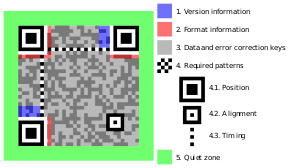A QR code (abbreviated from Quick Response code) is a type of matrix barcode (or two-dimensional code) designed to be read by smartphones. The code consists of black modules arranged in a square pattern on a white background. The information encoded may be text, a URL, or other data.
Created by Toyota subsidiary Denso Wave in 1994, the QR code is one of the most popular types of two-dimensional barcodes. The QR code was designed to allow its contents to be decoded at high speed.[1]
The technology has seen frequent use in Japan and South Korea; the United Kingdom is the seventh-largest national consumer of QR codes.[2Scan Me - Everybody's Guide to the Magical World of QR Codes
Overview
Although initially used for tracking parts in vehicle manufacturing, QR codes now are used in a much broader context. Uses now extend from commercial tracking to entertainment and from product marketing to in-store product labeling. Many of these applications are aimed toward mobile phone users (termed mobile tagging). Users may be receive text, add a vCardcontact to the user's device, open a Uniform Resource Identifier (URI), or compose an e-mail or text message after scanning QR codes. Users can generate and print their own QR codes for others to scan and use by visiting one of several paid and free QR code generating sites or apps. Google has a popular API to generate QR codes[3], and Apps for scanning QR codes can be found on nearly all smartphone devices. [4]
QR codes storing addresses and Uniform Resource Locators (URLs) may appear in magazines, on signs, on buses, on business cards, or on almost any object about which users might need information. Users with a camera phone equipped with the correct reader application can scan the image of the QR code to display text, contact information, connect to awireless network, or open a web page in the telephone's browser. This act of linking from physical world objects is termed hardlinking or object hyperlinking.
QR codes can be used in Google's mobile Android operating system via both their own Google Goggles application or 3rd party barcode scanners like ZXing or Kaywa. The browser supports URI redirection, which allows QR codes to send metadata to existing applications on the device. Nokia's Symbian operating system is provided with a barcode scanner, which is able to read QR codes,[5] while mbarcode[6] is a QR code reader for the Maemo operating system. In the Apple iOS, a QR code reader is not natively included, but more than fifty paid and free apps are available with both scanning capabilities and hard-linking to URI available. With BlackBerry devices, the App World application can natively scan QR codes and load any recognized Web URLs on the device's Web browser. Following an upcoming update, Windows Phone 7 will be able to scan QR codes through the Bing search app.

No comments:
Post a Comment